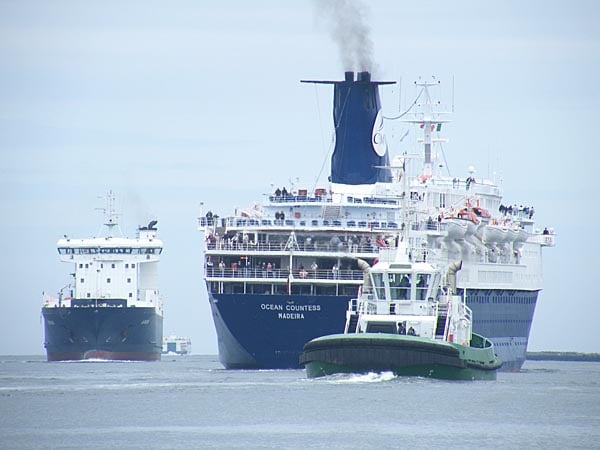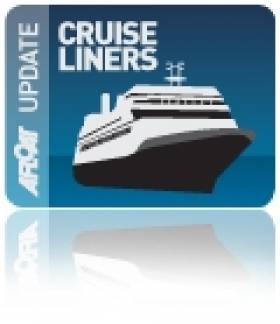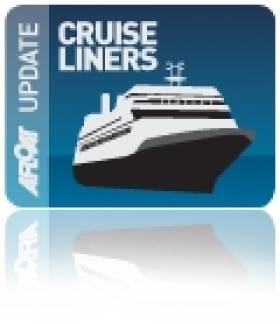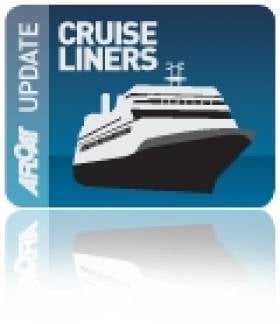Displaying items by tag: Princess Danae
Ports & Shipping Review: New Tallships Race and Cruise Operators, Superpower Naval Visitors, School at Sea, Irish Sea Excursions and Wind-Farms
#PORTS & SHIPPING REVIEW - Over the last fortnight Jehan Ashmore has reported from the Shipping scene where after the Irish Navy's role in the Tallships 'Parade of Sail', the inaugural Irish Sea Tall Ships Race finally got underway to Liverpool.
Also making a call to Dublin Port was cruise newcomer Plantour & Partners's whose small cruiseship Hamburg made her debut visit to the capital port.
The following day saw the classic cruiseship veteran Princess Daphne call, she was launched originally as a general cargo-ship serving the UK-Australia and New Zealand trade routes. In the same week her sister Princess Danae was arrested in Dublin Port, for an alleged non-payment of fuel bills. The dispute was eventually settled which saw the H&W built vessel depart for La Rochelle.
Operating profits at Irish Ferries of €3.2m for the first six months of 2012, remained the same compared to the same period last year, according to its parent company ICG which released its financial interim report.
A special call by the USS Fort McHenry (LSD-43), a dock landing ship to Dublin Port was made to coincide with American Football Week which allowed her crew to attend the Emerald Isle Classic showdown between the Navy and Notre Dame. On a related note US students where making their 'Semester at Sea' cruise on board Explorer which had called to Galway Bay and later the capital.
With the US Navy in Dublin, the rebel county had its own rare visit of the Russian Navy, when the destroyer Vice-Admiral Kulakov (626) called to Cobh. On both occasions the public were able to board.
Glasgow based Waverley Excursions have been running several unusual route excursions out of Northern Ireland. The final excursion was scheduled for today with a day-trip between Portaferry, Co. Down and Peel on the west coast of the Isle of Man.
While on waters off the east coast of the Irish Sea's largest island, proposals for an extended wind-farm will not require re-routing of shipping lanes according to developer Dong Energy. They operate the Walney Island wind-farm off Cumbria.
Detained Cruiseship Departs Dublin Port After Fuel Bill Resolved
#CRUISESHIP RELEASED – As previously reported, the Princess Danae (1955/16,531grt) which was at the centre of a dispute over an unpaid fuel bill departed Dublin Port last night, after the High Court set aside orders it had earlier granted detaining the vessel.
Yesterday afternoon the High Court ordered the arrest and detention of the Madeira registered vessel which arrived in Dublin yesterday morning, having sailed through the North Channel.
The 800 passenger and crew capacity cruiseship, was detained arising out of an alleged failure by its owners to pay an outstanding fuel bill of $94,000 (€74,940).
All but three bunks aboard the ship were occupied at the time Princess Danae was detained. The vessel was built originally as the cargoship Port Melbourne by Harland & Wolff, Belfast and is currently en-route to La Rochelle in western France.
#CRUISESHIP DETENTION – The High Court has ordered the arrest and detention of Princess Danae (1955/16,531grt) which arrived into Dublin Port today.
The cruiseship as previously reported on Afloat.ie, has a capacity to carry more than 800 passengers and crew, was detained arising out of an alleged failure by its owners to pay an outstanding fuel bill of US$94,000 (€75,000).
The former general cargoship, which is registered in Madeira, docked into the port's Alexandra Basin this morning and was due to depart at 7pm this evening.
A Classic Double Act: From General Cargoships to Cruise Liners
#CARGO TO CRUISELINERS – This morning saw the arrival of World Cruises Agency,'s Princess Daphne to Dublin Port, the veteran vessel built in 1955 was originally launched as a cargoship, writes Jehan Ashmore.
The 18,833grt cruiseship had arrived into Dublin Bay from Falmouth, however her cruise embarkation port was from Portsmouth, where World Cruises started their inaugural cruise call to Ireland. Yet again another newcomer operating in Irish waters this season.
In recent years Princess Daphne and her sister Princess Danae, have operated for Classic Cruises International (CIC), and they were among a fleet of older tonnage.
Before she became Princess Daphne, she was commissioned for Port Line (subsidiary of Cunard Line) and was built at the shipyard of Swan Hunter on Newcastle-upon-Tyne and launched as Port Sydney. She was joined by her sister Port Melbourne, also completed in the same year but built by Harland & Wolff. They were ordered to serve the UK route to New Zealand, Australia via the Panama Canal.
The handsome looking general cargoships or 'reefers' (handling meat exports) had a large superstructure, with accommodation for 12 passengers. Noting the wraparound passenger veranda deck and six cargo-holds accompanied by derricks for self-unloading.
Conversion work took place in 1975 and again this applied to her sister the following year. The rebuild included replacing the old superstructure with a large longer streamlined superstructure, noting fore-ward of the bridge are the derricks that was incorporated during the work. This feature does not apply to Princess Danae which has an extended structure instead.
They retain their have deep-drafted (7.9m) hulls, complete with many portholes along sheer classic lines. Princess Daphne has a hull length of 162.39m which is marginally longer then her sister's 162.31m.
Over their respective career spanning nearly six decades, they have operated for several owners and under different names, however their current names have remained for some time. The pair are both Portuguese flagged and operated by World Cruises based in Lisbon.
Incidentally Princess Danae (1955/16,531grt) will be making a call to Dublin Port tomorrow, as she is scheduled to arrive at her birthplace in Belfast Harbour today. Also in port, is Plantours & Partners Cruises Hamburg, which had sailed overnight from Dublin Port, as previously reported on Afloat.ie.
Dublin and Cork Share Cruise-Calls Bonanza
The ports of Dublin and Cork are scheduled to receive a record 139 cruiseships in total this year, bringing 180,000 visitors and crew. Many more of these cruiseships are due to visit over the next two months and stretching into late Autumn. Between €35-55m is expected to be generated into the Dublin region from high-spend cruise visitors
while a further €5m is predicted for the local economy at Cork, writes Jehan Ashmore.
A notable visitor due to grace Dublin Bay is the return of The World, albeit not strictly a cruiseship but the first custom-built time-share ship. The vessel is to dock in the capital for four-nights from 4-8 August and then sails overnight to Cobh, for two-nights from 9-11 August.
In essence, The World presents an exclusively unique lifestyle experience. Instead of passengers, there are 'residents' who live onboard. Residents of the 43,188 gross tonnes (GT) vessel don't merely occupy a cabin but own large-sized luxurously appointed private apartments that are 'home' complete with balconies.
On 9 August, Silver Cloud docks at Dublin from Oban, Scotland. Measuring 16,927 GT, the vessel may not be the largest with only 315 passengers, but is an ultra-luxury cruiseship, regarded as one of the highest standards in the cruise-sector industry.
Returning to Cork Harbour, Cobh awaits the mighty Independence of the Seas. At 154,407 tonnes, she is the biggest ever cruiseship to dock at any Irish port. With a massive 4,375 passenger capacity, attractions include rock-climbing or surfing-boarding using a special pool. The 'Independence' berths mid-afternoon on 29 August for an overnight call, departing 18.00hrs the next day.
Among smaller cruiseships, the private-motoryacht like, Island Sky of 4,000 tonnes and with 200 passengers, calls to Dublin on 11 August, and may berth upriver close to the new Samual Beckett Bridge.
Those keen on traditional ships, can look forward to the visit of Classic International Cruises Princess Danae, built in 1955. The veteran is due 16 August, and her sister, Princess Daphne is expected 2 September. Unusually the 16,000 tonnes pair were converted from general cargo-ships for a career in cruising.
New cruiseship, Costa Luminosa (92,700 GT) costing US $ 548m makes a second call to Cobh on 3 September and is operated by Costa Cruises.
This is the first time the Italian company has ventured into Irish cruising waters.
Without doubt the largest Dublin caller this season will be Emerald Princess. The giant weighs some 113,000 gross tonnes and at 288m long will certainly provide a spectacle, with lights blaring over a dozen or so decks, during a dusk departure on 14 September.
Also entering service this year, P&O Cruises 116,000 tonnes new Azura, is set to visit Dublin on 23 September and Cork the next day. The Italian built newbuild cost US $ 535m and has a capacity for 3,076 passengers.

Ocean Countess departing Dublin. Photo: Jehan Ashmore/ShipSNAPS
A newcomer to Irish ports is Cruise & Maritime Voyages Ocean Countess which is making round Ireland itineraries with calls at Cobh on 13 August and 12 September. Incidently the 'Countess' was converted into a troopship for the Falkland Islands conflict in 1982.
Jewel of the Seas (90,090 GT) makes a Cobh call on 7 September and exactly a month later returns, marking the last cruise-call to Cork in 2010 while Fred Olsen's Boudicca will be Dublin's last caller on 20 November.
For further information on other visiting cruiseships, please click links:

































































